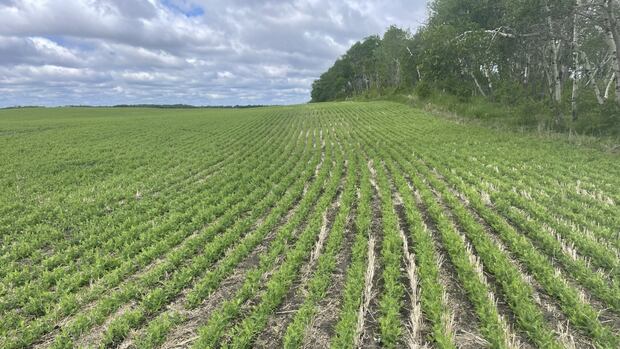Not just a 'dry heat': why humidity is surging in Sask. this summer
Climate change could mean higher humidex values on the Prairies

Saskatchewan is known for its hot and dry summers.
But this summer, things haven't been so dry.
Humidex values during the last full week of July soared above 40 in parts of southern Saskatchewan.
Estevan reported 12 days this July with a humidex at or above 35. It usually sees about four or five days in a typical July.
Humidex — a word that blends "humidity" and "index" — measures how hot it feels when humidity is combined with temperature. The higher the humidity on a hot day, the hotter it actually feels.
A humidex of 40 to 45, according to Environment and Climate Change Canada (ECCC), can cause "great discomfort" and it's recommended you avoid physical exertion.
Humidex is also a factor ECCC considers when issuing heat warnings. In roughly the southern half of the province, they're issued when the humidex exceeds 38 for two or more consecutive days; and in roughly the northern half, they're issued when it exceeds 34.
Water, water, everywhere
Humidity is the amount of water vapour — or water in the form of a gas instead of a liquid — in the air.
That water vapour is formed when water evaporates from the ground into the air.
And there's been plenty of water on the ground for that to happen, with much of the province receiving above-average moisture this spring and summer.
On the Prairies, some amount of humidity is almost always guaranteed each summer when crops grow.
"They give off a tremendous amount of moisture called evapotranspiration," said Terry Lang, a meteorologist with ECCC.
"The past few years have been really, really dry and we know the crops haven't done really well so they haven't been giving off this evapotranspiration."
Lang said strong weather systems that originate off the coast of British Columbia and move through the Prairies in summer not only bring additional rain, but they also can draw in moist air from the Gulf of Mexico.
"It's also going across the (U.S.) Midwest which is also growing a lot of crops as well," she said.
Lang expects humidity to drop in the coming weeks as crops are harvested.
Climate change could mean higher humidity: scientist
Don't expect this to be the last summer with high humidity.
Trevor Murdock is a climate scientist with the Canadian Centre for Climate Services. He said climate change will likely only increase humidity.
"Warmer air can hold more moisture," said Murdock.
"Climate change also … is causing increased precipitation. And so the warm and potentially wetter events during the summer in the Prairies together are projected to bring increases in this humidex index that we use."
The Prairies are expected to see more intense drought and severe forest fire seasons as a result of climate change.
But the area could also end up seeing more rain, too.
Murdock said because warmer air can hold more moisture, rainfall events could become more intense.
"So you can get both an increase in the dry season, increase in the dry spells, but then when it rains, it pours," said Murdock.
"It sounds like these are potentially contradictory, but these are the kinds of changes in extremes of opposite kinds that climate change can drive."
Data from CBC News and the Canadian Centre for Climate Services shows Regina sees around five days a year with a humidex above 35. That number could jump to 29 days by the year 2071, even if greenhouse gas emissions fall off mid-century.
Things are not always as they seem
Despite a warming planet, some arid and semi-arid regions of the world — which could include Saskatchewan — are not getting more humid.
That research was presented in a January report from the National Center for Atmospheric Research in Boulder, Colo.
Isla Simpson, the lead author of the study, told CBC that water vapour levels in places like the southwestern United States, South Africa and Australia have not increased in the last 40 years or so.

"Water vapour has stayed fairly constant on average in these arid and semi-arid regions even though temperatures have risen considerably," Simpson said.
Even in the driest months of more humid regions around the world, Simpson said water vapour is also not rising to the same extent that was expected.
The answer as to why is still a mystery. But Simpson and her team believe a main reason is that climate models may be overestimating how much water is available to the atmosphere in drier regions.
"Even if the atmosphere warms, maybe it's not able to get as much water as it wants from the surface because there just isn't enough available to it," she said.
Simpson stressed more research is needed to find the answer.


